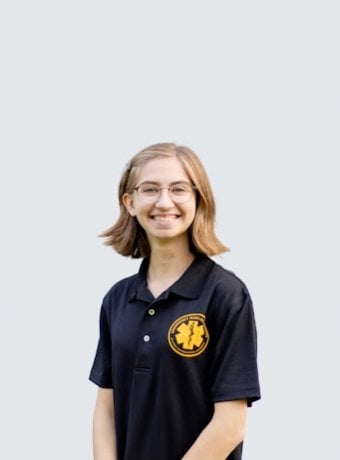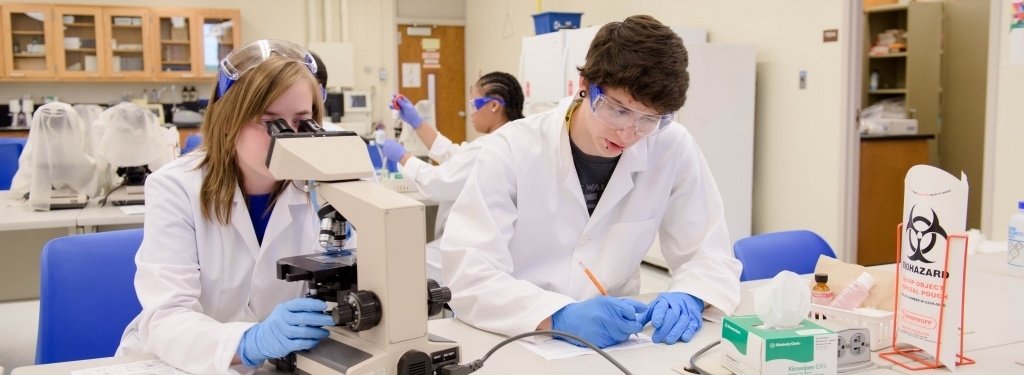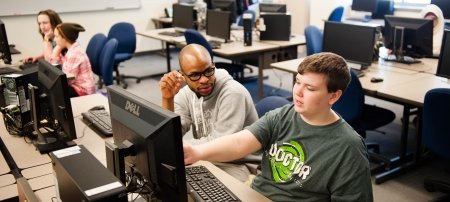Michigan Tech alumna Dr. Erika Crook cares for creatures great and small.
"There's a lot of things I've never done," says zoo and wildlife veterinarian Erika Crook. But her job includes things most people will never do, like figuring out why a pregnant zebra gets hives, tending to a scarlet ibis with a broken beak, and performing wellness checks on lion cubs.
The 1993 Michigan Tech biology graduate can't predict what's going to shake up the routine on any given day—could be a sneezing elephant, or a snake suffering from bloat. Maybe a monkey with a dislocated wrist, or an ailing sea star in need of an MRI.

From 8,000-pound pachyderms to five-gram toads, Crook attends to the health-care needs of a multitude of species in each cycle of life at Utah's Hogle Zoo, in Salt Lake City. In 2016, she eased the passage of the then-oldest giraffe in North America, 31-year-old Daphne. "She let us know when it was time," she says. Crook helped Nora the polar bear recover from both emotional and physical maladies. She vaccinates baby tigers, and helps new residents, like the pair of red pandas that came to the zoo earlier this year, settle in. Crook works with a staff of four in the veterinary department and about 150 employees zoo-wide.
She also pursues field opportunities beyond her home zoo. She surveyed the health of the bird populations of the Galapagos Islands, specifically its penguins and flightless cormorants. She joined tree kangaroo conservation efforts in Papua New Guinea, and surgically placed radio transmitters in venomous snakes in Armenia (she slept in the Russian mountains with 11 bagged, yet-to-be-released vipers stowed under her bed).
"I'm the most generalized specialist you'll ever meet."
Crook earned her Doctor of Veterinary Medicine degree from Michigan State University. A diplomate of both the American College of Zoological Medicine (2008) and the European College of Zoological Medicine (2017) she's qualified to treat every animal on the planet.
For Crook and the zoos and organizations she works for and with, conservation—conserving species, conserving habitat around the globe—is the overarching mission. "The goal of a modern zoo is to educate the public to care about wild animals and wild places in order to try to save many of the species which are on the brink'" she says.
"At this time, people are the most dangerous animals on the planet. Some of the damage we are doing may not be reversible. In our lifetime it is possible that certain rhino and big cat species could go extinct."
While involved in several other conservation programs, Hogle Zoo is using a specially designated "Big Six" initiative to go beyond zoo boundaries and focus on care and conservation of six key species in the wild: the boreal toad of Utah, Orangutans of Malaysia, Alaskan and Arctic polar bears, the radiated tortoise of Madagascar, and African elephants and lions. In the latter case, the zoo has a full pride.

"We hope that we can help bring awareness to their habitat and the other species in their vicinity that share their ecosystems," Crook says. "While I have worked with each of these species at the zoo, my hope is that as our conservation initiatives broaden I can work with those species in their native habitats."
Crook built a solid education foundation at Michigan Tech that resulted in acceptance into medical school. Born in Mexico and hailing from downstate Troy, Michigan, she qualified for a four-year full-ride minority scholarship to Tech. She's grateful for the funding opportunity, as well as the support she received from inspiring campus educators and leaders, finding inspiration in other courses as well as her biology major.
"Gloria Melton was my mentor," she says. "I was a member of the minority council Dr. Melton led. She was always so friendly, encouraging, down to earth, and inclusive. She made an effort to get to know the students and make us feel important as individuals." Melton, then-coordinator of minority student services, was dean of students from 2004 until her retirement in 2011.
Q&A
Q: Did you always know you wanted to be a veterinarian? How did you choose Michigan Tech?

A: I always knew, and it was apparent to my family, too—as a little girl growing up in Mexico City I would get very upset about the stray dogs on the streets. I had Airedale terriers, and worked at a kennel in high school. I learned about Michigan Tech when we visited the campus with my brother, who's a year older than me, looking at engineering schools. I fell in love with the size of the campus, the atmosphere, and the location. My best friends my freshman year were forestry majors. For a minute I wavered, thinking that maybe I wanted to be a forestry major, too. And even though I didn't become a plant doctor, I fondly remember how wonderful and passionate Dr. Janice Glime was.
Dr. Ronald Gratz was my pre-veterinary mentor and professor. I was in Blue Key, Delta Zeta, did campus tours, and worked the front desk at East Coed (now known as McNair) Hall. I spent a couple summers in Houghton and enjoyed the Keweenaw Peninsula. The week before I went to veterinary school I went backpacking on Isle Royale with a student who worked with Dr. Rolf Peterson on the island. We saw lots of moose and even a wolf!
Q: You work full-time at Utah's Hogle Zoo in Salt Lake City, but you've also been able to get out into the field—way out into the field. What are some of the most memorable experiences? What other zoos and projects have you worked with?
A: I love my day job at the Hogle Zoo as a zoo clinician, but the icing on the cake is having fieldwork experiences. My entry into this field was an internship at the Shedd Aquarium and Lincoln Park Zoo in Chicago. Some of my first patients were gorillas, warthogs, sharks, stingrays, and beluga whales. During a three-year residency at the Saint Louis Zoo's WildCare Institute I had unique opportunities for in situ conservation.
I've been to the Galapagos three times, to participate with Dr. Patricia Parker's avian disease surveys to understand what the endemic bird populations have been exposed to. This required me to live aboard a small research vessel while not getting seasick in order to evaluate the Galapagos penguins and flightless cormorants (seen in the Russell Crowe movie Master and Commander) around Isabela and Fernandina islands.
In Madagascar, I joined a team working in the northern part of the country doing health assessments on six different lemur species, ranging from the tiny mouse lemur to the critically endangered Perrier's sifaka. We lived in a village; the people shared their dry river bed with us to dig holes to try to collect drinking water.

In southern Armenia, I surgically placed radio transmitters in three viper species as part of a PhD project for Dr. Jeff Ettling investigating the home ranges of the snakes. Armenia takes a lot of pride in its natural resources and national parks. By understanding and conserving snake habitat, a lot of species win.
In Papua, New Guinea, I hiked into remote old-growth rain forests (read: leeches and heavy rain) to work with wild Matschie's tree kangaroos, placing radio collars and performing health evaluations. The work, through the Tree Kangaroo Conservation Program, has helped create the first conservation area of tribal land in the country, and helps local villages improve education, health, and sustainability. A highlight was seeing healthy pouch joeys while doing a physical exam on the tree kangaroos.
Q: Have you ever been bitten or attacked? What's the scariest animal you work with?

A: Yes, I can lay claim to having been bitten by the only penguin species (Galapagos penguin) that lives north of the equator. At Hogle, we do protective contact training with all dangerous species, which means that we're not in the same space with them. But when we're doing procedures on big animals —a tiger, polar bear or orangutan—it is 'game on with a game face'—I'm responsible for both animal and human safety. Every zoo vet has scary stories about an animal starting to wake up under anesthesia. I always have extra drugs in my pocket just in case, and I have learned through experience that you need to know where all your exits are. I'm first to go into the treatment area to determine anesthesia level, and it's my call when we mobilize the animal.
Q: What's the hardest animal to care for?
A: That's a hard question. Maybe dying giant green anemones, disintegrating into a mess. There was nothing we could do; they were attached to a rock. We still don't know what was happening in that tank. I'm not an expert on invertebrates.

Each species has its challenges. Sometimes the animals need our medical care and sometimes they heal on their own. We had a female orangutan that had lockjaw for days, but luckily she could take liquids via a straw and Tylenol off a spoon. We had a tiger with a severe erosion on the roof of her mouth that was causing eating problems; eventually the issue resolved on its own. We had a giraffe with a degloving injury to her distal tail, leaving exposed bone. This required a standing sedation tail amputation and bandage. We had a Pacific sanddab (flat fish) that had large bubbles of air in one eye. We performed anesthesia and an eye removal with excellent results. One of the most important things for animals in managed care is to try to provide the best environment and diet possible. Zoos don't always get it right but we try our best.
Q: What medical professionals do you consult with?

A: Many specialists, human and veterinary, are willing to lend time and expertise to help with zoo cases. They enjoy the novelty and unique challenge of work on a non-human case. We have excellent veterinary colleagues close by that are board-certified in surgery, ophthalmology, emergency/critical care, and cardiology, to name a few. Specialists have helped us with a polar bear who needed exploratory surgery, an ocelot with a broken leg, a snow leopard with a deep eye ulcer that was patched with equine amnion, a gorilla that needed extractions and a canine root canal, and diagnostics on a sick 600-pound sea lion. On the human medicine side of things, we worked with a hepatologist when our jaundiced tiger had advanced liver failure (we pulled him through it!), a kidney specialist when a snow leopard with kidney stones needed scoping and lithotripsy, a breast cancer surgeon for a lumpectomy on a male orangutan with breast cancer, and an ear, nose, and throat specialist for a howler monkey with a wicked sinus infection who needed to have the pus pockets flushed out. A few zoos are fortunate to have their own CAT scan machines; we aren't one of them yet. So we work with specialists in advanced imaging for some of our more challenging cases. Some examples are a bloated sea star (she was filled with eggs), a non-venomous snake with cloacal cancer, and a female gorilla with advanced reproductive disease.
Michigan Technological University is an R1 public research university founded in 1885 in Houghton, and is home to nearly 7,500 students from more than 60 countries around the world. Consistently ranked among the best universities in the country for return on investment, Michigan's flagship technological university offers more than 120 undergraduate and graduate degree programs in science and technology, engineering, computing, forestry, business, health professions, humanities, mathematics, social sciences, and the arts. The rural campus is situated just miles from Lake Superior in Michigan's Upper Peninsula, offering year-round opportunities for outdoor adventure.





